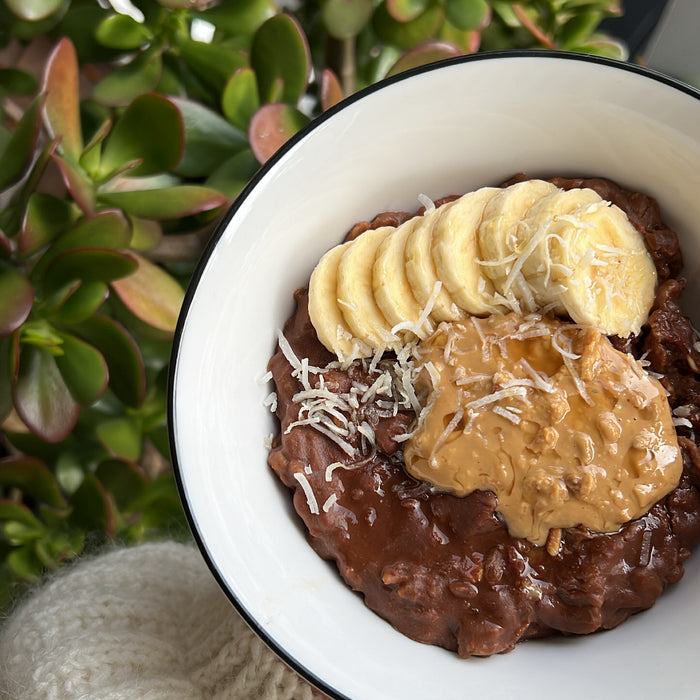Adaptogenic Porridge Bowl


Plastic is everywhere. It is unquestionably the world’s most versatile material and is used in everything from buildings, to cars, to pens, to furniture to food packaging. Unfortunately, plastic does not break down easily, if at all, and could pollute the environment long after we ourselves have left the Earth. As of 2018, 380 million tons of plastic is being produced worldwide every year, with 90% of these plastics being un-recyclable and entering oceans, rivers and seas, being pumped into landfill and killing animals in their natural habitats. Researchers suggest that at this rate, by 2050 there will be more plastic in the ocean than fish!!
So, what can we do about this ever-increasing plastic problem? Part of the solution could simply be educating ourselves on plastic alternatives and the pros and cons of each.
Traditional Plastics
TraditionalPlastics are carbon-based polymers made from oil. On average each plastic item that is produced in the world is used for 12 minutes prior to being binned, yet they can take over 500 years to break down in the natural environment. Disposing of all plastic is almost impossible, as there are so many different types, each with its own different refuse process.
Biodegradable Plastics
Biodegradable plastics are made of biopolymers that contain additives that make them more degradable in the presence of light and oxygen. They commonly only degrade in industrial composters through a chemical process called biodegradation where plastics are metabolised into water, CO2 and biomass. Unfortunately, biodegradable plastics break down much more slowly in domestic compost systems, and through this process can emit methane gas into the atmosphere and leave behind toxic chemicals and micro-particles. If left to enter waterways, biodegradable plastics will float forever on the surface of rivers and oceans without breaking down, potentially killing marine life in the process. There are however some biodegradable landfill products, such as Biogone cling wrap (used and sold at Santos Organics), which contain additives that completely breakdown in 3 to 5 years in normal landfill conditions - and as such is still a better product to use compared to traditional plastic clingwraps.
Degradable Plastics
Degradable plastics are oil-based like traditional plastics. They break down when exposed to UV rays and physical stressors. But just like bio-degradable plastics, they do not break down well in the natural environment. Because of how biodegradable and degradable plastics break down in the natural environment, they often fragment into tiny micro particles (MP). These microplastics then mix with dissolved organic matter (DOM) in soil, algae and are also eaten by small marine animals. Eventually microplastics make their way into the human food system. Research indicates that we eat on average 840 micro-plastics every year!

Compostable/Bioplastics
Compostable plastics, also known as bioplastics are made from biomaterials such as corn starch and are called Polylactide acid (PLA). PLA takes only two thirds of the energy to produce compared to traditional plastics, and produce 70% less greenhouse gases as they break down. Bioplastics are also compostable and decay within weeks into natural materials that blend into the soil. Most bioplastics look indistinguishable from their traditional plastic counterparts and are widely used for food containers, straws, and bin liners. Unfortunately, there are still some bioplastics that leave toxic residue or plastic fragments behind, so it is very important to ensure you are using the most ethical options on the market - such as Cardia bin bags, which are readily available at Santos Organics.
How do I Recycle Correctly?
Before recycling we should get into the habit of refusing, reducing and reusing as much of our plastic waste as possible. This will ultimately reduce the production of plastics and it's effect on the environment. The main plastics to avoid purchasing altogether are: PVC (the most damaging of all plastics), PS (foam and polystyrene), and PC (polycarbonate).
Small things can be done to reduce plastic use on a personal level such as using bees wax wraps instead of cling wrap, and shampoo and soap bars rather than liquids in plastic bottles; as well as eliminating use of all single use plastic bottles, cups and cutlery by carrying your own reusable alternatives. While living a completely plastic free lifestyle in the current world is still very difficult, learning how to recycle plastics correctly is imperative for a more sustainable world:
The best way to learn more about how to recycle you plastic waste correctly in your local area is by visiting your local council recycling website. In Byron you can find information here: https://www.byron.nsw.gov.au/Services/Waste-recycling/Recycling/What-you-can-and-cant-recycle
Written by Megan Lee
Email: megan.lee@scu.edu.au
Instagram @meganlovingmeagain
Twitter @MeganLeePhD